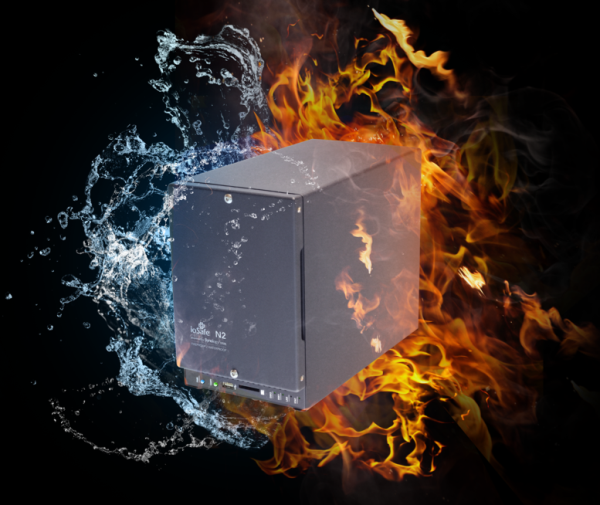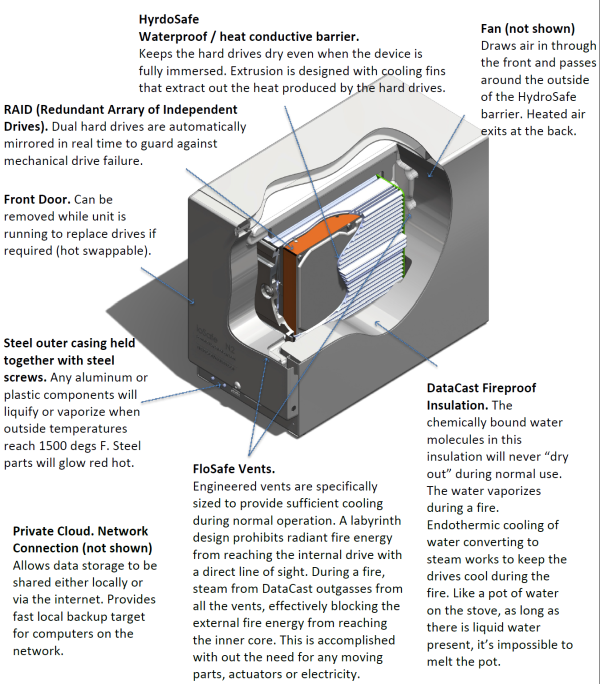ioSafe N2: A Disaster Proof NAS with Synology DSM
by Ganesh T S on September 18, 2012 11:50 AM EST- Posted in
- IT Computing
- Storage
- Synology
- ioSafe
ioSafe used to manufacture disaster proof NAS solutions / backup appliances such as the ioSafe R4. The R4s used to cost upwards of $10K, weighed more than 120 lbs. and the hard disks, though hot-swappable, needed a proprietary coating for waterproofing prior to usage. After taking a small break from the disaster-proof NAS market, ioSafe is back today with a new version, the ioSafe N2. It addresses all the shortcomings of the R4 by bringing down the weight to a more manageable 28 lbs. Hot swapping with standard hard drives is also supported, and the price for a diskless unit is a consumer friendly $599. Based on the Synology DSM (Disk Station Manager) firmware, the N2 is a 2-bay NAS unit with a 2 GHz Marvell CPU at the core along with 512 MB of DRAM. The performance, therefore, should be similar to that of the Synology DS213.
We had carried out a detailed analysis of ioSafe’s technology in our review of the SoloPRO earlier this year. The following picture shows the various aspects being used in the ioSafe N2.
A summary of the ioSafe N2 specifications is provided below:
Features:
- Local and Remote File Sharing: Between virtually any device from any location online
- Cloud Station: File syncing between multiple computers and N2 (like Dropbox)
- iTunes Server
- Surveillance Station: Video surveillance application
- Media Server: Stream videos and music
- Photo Sharing: Photo sharing with friends and family
- Mail Server: Email server
- VPN Server: Manage Virtual Private Network
- Download Station: Post files for others to download
- Audio Station: Stream audio to smartphone (iOS/Android)
- FTP Server: Remote file transfers
- Multi-platform compatibility with Mac/PC/MS Server/Linux
Hardware:
- Dual Redundant Disk, RAID 0/1, Up to 8TB (4TB x 2)
- 2GHz Marvel CPU and 512MB memory
- Gigabit Ethernet Port
- Additional ports for USB 3, SD Memory Card
- User replaceable drives
- Protects Data From Fire: DataCast Technology. 1550°F, 1/2 hr per ASTM E119 with no data loss.
- Protects Data From Flood: HydroSafe Technology. Full immersion, 10 ft. 3 days with no data loss.
- FloSafe Vent Technology: Active air cooling during normal operation. FloSafe Vents automatically block destructive heat during fire by water vaporization - no moving parts
- Physical theft protection (optional floor mount, door security - coming Q1 2013)
- Kensington® Lock Compatible
Support:
- 1 Year Data Recovery Service (DRS) Standard (upgrade up to 5 year)
- DRS included $2500/TB for forensic recovery costs for any reason if required
- 1 Year No-Hassle Warranty - Upgrades with DRS up to 5 years
Operating Environment:
- Operating: 0-35° C (95°F)
- Non-operating: 0-1550°F, 1/2 hr per ASTM E119
- Operating Humidity: 20% - 80% (non-condensing)
- Non-operating Humidity: 100%, Full water immersion, 10 feet, 3 days
Physical:
- Size: 5.9"W x 9.0"H x 11.5"L
- Weight: 28 lbs
ioSafe's CEO, Robb Moore, had responded to many of our questions and concerns in the comments section of our review of the ioSafe Solo PRO. Of particular relevance to today's piece is the 3-2-1 backup strategy advocated by ioSafe:
- Keep at least 3 complete copies of your data
- Keep them on at least 2 different devices
- 1 copy should be on taken offsite or disaster proofed in someway
Many consumers wish to have some sort of RAID-1 redundancy built into their backup strategy (We all know 'RAID is not backup'). For example, a disaster proof backup system could consist of a 2-bay NAS such as the Synology DS213 ($299), two 2TB drives (2x $100) and a 2TB SoloPRO ($370) costing $869 in total. Another way of implementing the 3-2-1 strategy would be an ioSafe N2 ($599), two 2TB drives ($200) and a generic 2TB external hard drive ($100) costing $900 in total. Both setups would give fireproof and waterproof backups with private cloud access, NAS and RAID. The second strategy does deliver a slight advantage:
- Post disaster, the user gets two chances to recover data from each drive.
- Drive failure doesn't result in losing fire/flood recovery ability
- Disaster-proofing the primary drives gives the user better recovery of the data that was in process moments before a natural disaster, giving an improved Recovery Point Objective (RPO). The SoloPRO in the first scenario might only have last nights backup depending on the user's settings.
- Getting to the disaster exposed drive is easier on the N2 because of the hot swappable nature of the drives and the lesser number of screws (Improved Recovery Time Objective (RTO))
The ioSafe N2 is being launched on Indiegogo today. General availability is scheduled for January 2013 with a retail price of $599.99 for the diskless version. Considering that ioSafe is a small company with 20-odd employees, crowdfunding initiatives like Indiegogo allow them to jump past typical startup funding models and rapidly accelerate the ioSafe N2 to market.
It is exciting to see ioSafe address the market for disaster proof network attached storage. This market is not necessarily as glamorous as the one that a recent crowdfunding hit managed to raise millions of dollars for. However, most consumers don't realize the value provided by solutions such as those provided by ioSafe until it is too late. With the final version of the ioSafe N2 already being demonstrated and the solid track record of ioSafe in the disaster proof storage market, we hope ioSafe is able to successfully reach out to the consumers through this initiative.


















15 Comments
View All Comments
Jeff7181 - Tuesday, September 18, 2012 - link
"Private Cloud?" That's a bit of a stretch of the definition. Seems like by that definition, any resource that is accessible via the Internet to which access is limited is a private cloud.Now if you could network these together over the Internet, and have your data spread across multiple devices and there was some ambiguity as to what data is on which device, that would be a private cloud in my eyes.
robb.moore - Tuesday, September 18, 2012 - link
Hi Jeff-Thanks for your comment. We're calling this a "Private Cloud" because it leverages all the great work done by Synology over the years. There are an abundant selection of applications for smartphones, tablets and computers that allow you to access your data from anywhere on just about any device. Terabytes of data can be easily stored and managed locally or remotely.
The huge advantages with the private cloud are speed, cost and security. There's no practical way for the small business or prosumer to push/pull terabytes of data across an internet connection. It can costs thousands per month in online fees. Large databases are huge targets for hackers (Amazon S3, Apple iCloud, etc.).
To your comment, you should think of this product like a building block for data protection. You could easily place multiple units around your local network (wireless LAN hidden in a closet?) to build as much storage, redundancy and protection as your budget affords. Use in a way that makes sense for you.
Robb Moore
CEO
ioSafe
zanon - Tuesday, September 18, 2012 - link
While I'd prefer to see an option with more drives (I think 5 is really a sweet spot) that would presumably just be a matter of scaling up if they do well, and overall it looks like a solid bit of kit. However, given the emphasis on reliability I wish it had the ability to run something like FreeBSD and ZFS. That would give many more, better options for replication, performance, and help guard against corruption and other forms of loss too. Having that as a base would also open up the possibility of users adding things like multifactor support for improved security without ioSafe having to be responsible.It's good to see options like this being considered though, and this seems like a good foundation for future products. I'll definitely be watching for what ioSafe comes up with down the road.
Nacho - Tuesday, September 18, 2012 - link
I think you are missing the target for this product: Fire + water proof backup, with raid for increased reliability.Kevin G - Tuesday, September 18, 2012 - link
I'd like to see some of the claims independently tested to see if they hold up. I'd rather know that the data can survive before hand rather than finding out they can't after an incident.bobbozzo - Tuesday, September 18, 2012 - link
Hi, Please use the term Disaster-RESISTANT instead of proof.Coup27 - Tuesday, September 18, 2012 - link
I remember reading the previous article and seeing the hole in the product line with a NAS ioSafe missing. I will definitely look at one when I finally get my own house later this year.Regarding proof vs resistant, I presume they make the claim proof because a disaster is likely to last only so long. If your home catches fire it the room where the safe was located will not burn intensely for 10 hours and the unit is water tight for 72 hours. Unless it was caught in a jungle fire or tsunami it's going to survive.
Impulses - Tuesday, September 18, 2012 - link
Doesn't take a tsunami for floods to last longer than 72 hours...DanNeely - Tuesday, September 18, 2012 - link
I asked a similar question about the firerating on the article about a previous ioSafe product and was given this in answer:"Hi Dan-
The average house fire lasts 10-20 minutes at about 1100 degrees. Almost all fires involve water. In fact most of the damage is done by the fire fighter hoses than by the fire. Typically, when a room burns, all the fuel in the room is used up in a relatively short time. If a building burns for a couple hours, it's not the same spot burning as the fuel gets used up over a few minutes.
1400 degrees is a VERY hot section of the fire (typically right at the ceiling. As you move downward in the room, the temps drop into the 300-400 degs F near the floor.
-Robb
Robb Moore
CEO
ioSafe "
evilspoons - Tuesday, September 18, 2012 - link
"iTunes Server"? Has Apple transitioned iTunes to some sort of client/server model?